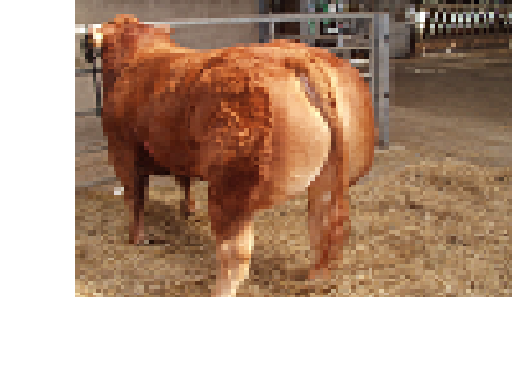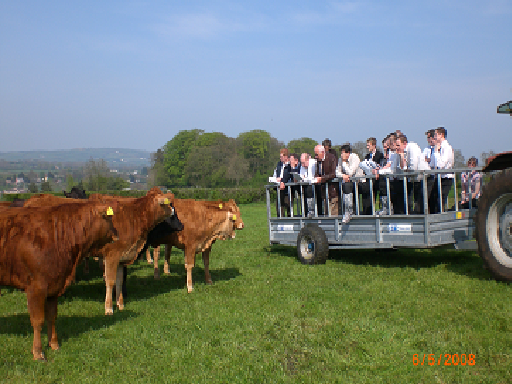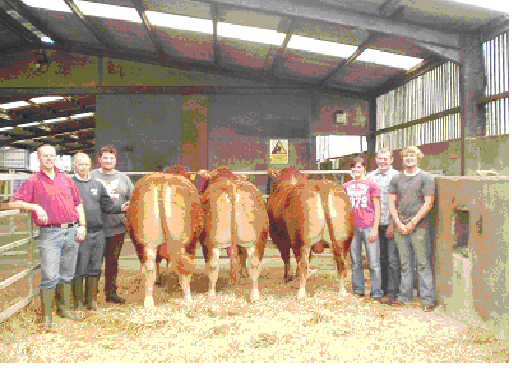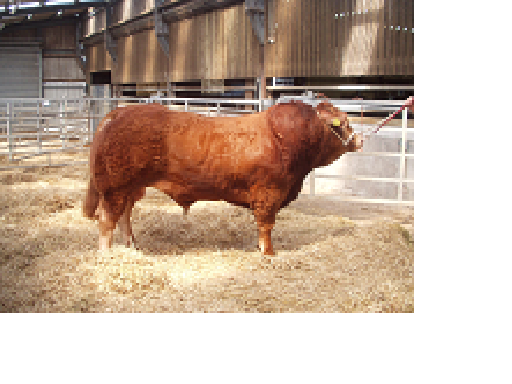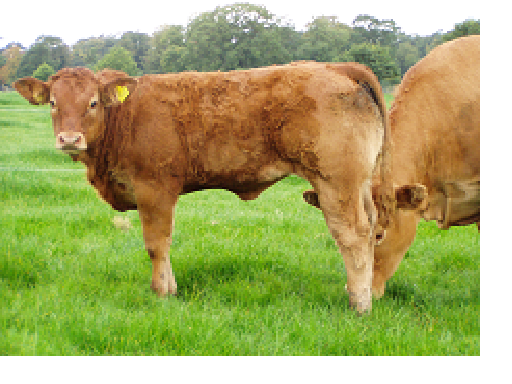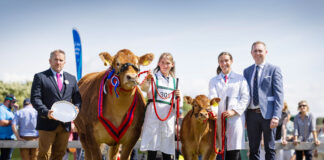By Stephen Clyde, Farm Manager, Abbey Farm, CAFRE, Greenmount Campus
One of the longest running educational projects has come to an end at the College of Agriculture, Food and Rural Enterprise (CAFRE), Greenmount Campus, Northern Ireland with the dispersal of the LIMO (Leading Industry to Meat Objectives) herd on the 6th October 2010.
The herd comprised of 25 pedigree and 25 threequarter bred cows and was set up in 1997 in conjunction with the British Limousin Cattle Society to allow CAFRE students to gain first hand practical, hands-on experience of breeding and management of a substantial herd of pure bred beef cattle. In addition to the experience gained by the many students who participated in the project it proved to be a valuable asset in providing the beef industry with performance data and costs – particularly in relation to maternal values.
A lot of the experiences gained with LIMO were also built into the Beef Quality Initiative (BQI) project (2001-2009) which proved a major asset to the Northern Ireland beef sector.
The decision to disperse the LIMO herd was taken after serious consideration and full consultation with the various bodies representing the Northern Ireland beef sector. This change in policy will allow CAFRE to build on the experience of the LIMO project and investigate and develop new initiatives focused particularly on crossbreeding in the lowland suckler herd situation. This is a key recommendation from the Northern Ireland Red Meat Industry Task Force.
Report on 2010
The pedigree first calving heifers calved in February. These heifers calved to Limo Colt, a Dauphin son and out of the impressive Limo Verse. Colt has a Beef Value of LM+50 and a milk figure of +8. He was used on the pedigree heifers and the entire crossbred herd whose calves were impressive showing plenty of growth, power and muscling.
The cows started to calve down at the beginning of April. 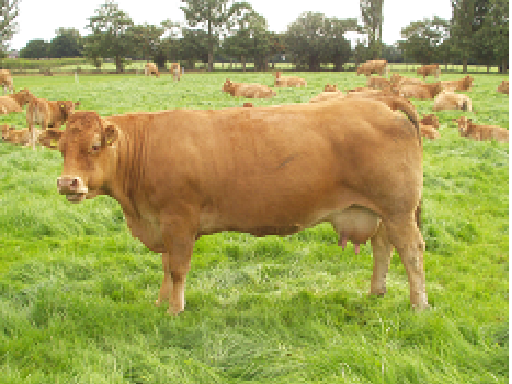 Most of the cows calved to the leading Limousin sire, Wilodge Cerberus, who had been sold for 50,000gns at Carlisle. With a Beef Value of LM+42 and a muscle depth of 6.6 his calves proved to be easily calved with the calves showing plenty of growth, style, correctness and muscle. The crossbred heifers calved in February and the crossbred cows started to calve in March without any serious difficulties and produced impressive Colt offspring. The crossbred and pedigree cows and calves were not turned out to grass until 30th April, due to the late spring resulting in very poor grass growth.
Most of the cows calved to the leading Limousin sire, Wilodge Cerberus, who had been sold for 50,000gns at Carlisle. With a Beef Value of LM+42 and a muscle depth of 6.6 his calves proved to be easily calved with the calves showing plenty of growth, style, correctness and muscle. The crossbred heifers calved in February and the crossbred cows started to calve in March without any serious difficulties and produced impressive Colt offspring. The crossbred and pedigree cows and calves were not turned out to grass until 30th April, due to the late spring resulting in very poor grass growth.
The pedigree and crossbred calves received two worm doses throughout the year. The only other routine treatments that they received were Blackleg vaccine and Rispoval-P. The pedigree calves were treated with Rispoval-3 and the cross bred calves were treated with Rispsoval 4 for pneumonia before sale and housing respectively. Creep feed was offered to the pedigree calves from mid-July to prepare them for sale. The crossbred calves were offered bruised grain from mid October. Prior to this, these calves achieved an average weight gain of 1.12Kg/head/day (on their mother’s milk and grass).
Grazing Management
The pedigree and crossbred heifers were rotationally grazed on paddocks as part of a new grazing management project initiated at the beginning of this year. This involved the measurement of grass covers each week using the rising plate meter. A rising plate meter can be used to measure grass covers until sufficient experience is gained by visual assessment. Targets were set for pre- and post grazing heights with the emphasis on ensuring cattle were offered the very best quality grass throughout the season. Pre-grazing grass covers were set at 3000 kg/DM/ha (12-15cm) and post grazing covers at 1600 kg/DM/ha (4cm). The paddocks were topped to 4cm after each grazing to ensure a fresh leafy regrowth. Daily dry matter intakes were estimated based on the average weight of the group and depending on the quantity of grass 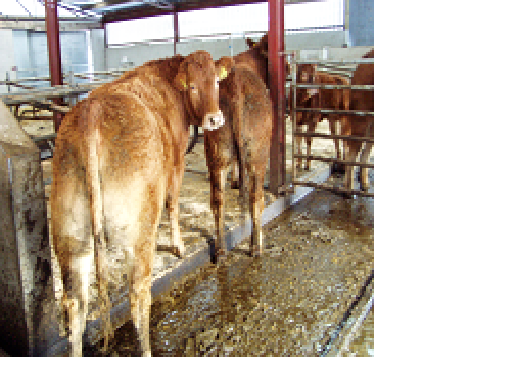 available and predicted grass growth the number of grazing days ahead was determined. The target for the early season grazing was set at 12-14 days and increased as the autumn time approached. Where grass growth outstripped demand some paddocks were taken out of the rotation and round baled. In instances where there was a grass shortage silage area was buffer fed. On this system the Limo crossbred heifers gained 0.84kg liveweight gain per day and 188kg/liveweight over the grazing season which was good considering the late turn out date. These heifers were kept as replacements to build up the crossbred herd following the sale of the pedigree cows.
available and predicted grass growth the number of grazing days ahead was determined. The target for the early season grazing was set at 12-14 days and increased as the autumn time approached. Where grass growth outstripped demand some paddocks were taken out of the rotation and round baled. In instances where there was a grass shortage silage area was buffer fed. On this system the Limo crossbred heifers gained 0.84kg liveweight gain per day and 188kg/liveweight over the grazing season which was good considering the late turn out date. These heifers were kept as replacements to build up the crossbred herd following the sale of the pedigree cows.
Two maiden cross bred heifers that will form the foundation stock for a new commercial lowlandsuckler herd at the Abbey Farm
The students get a chance to see the new grazing policy first hand at their board meeting.
 The students get the benefit of Jim Quail’s experience on what makes a top quality carcase and why he prefers Limousin for his butcher’s shop. The better the grade, the better the kill out percentage gives an outcome of more lean meat content for sale and less wastage. This all helps to lower the carbon footprint of the meat produced.
The students get the benefit of Jim Quail’s experience on what makes a top quality carcase and why he prefers Limousin for his butcher’s shop. The better the grade, the better the kill out percentage gives an outcome of more lean meat content for sale and less wastage. This all helps to lower the carbon footprint of the meat produced.
Beef sales 2010
The last 16 LIMO heifers that were slaughtered as part of the project had an average carcase weight of 333kg and graded 1E, 8U and 7R fat classes 3&4L and made an average price of £873. The kill out percentages were mostly between 56-60.8%.
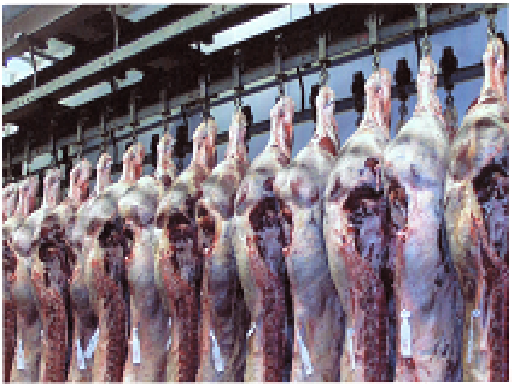 The last 32 LIMO bulls slaughtered for beef under 16 months as part of the project had an average carcase weight of 400kg and graded 6E and 26U’s, all fat classes 2&3, their kill out percentages ranged from 58% to 63% and made an average
The last 32 LIMO bulls slaughtered for beef under 16 months as part of the project had an average carcase weight of 400kg and graded 6E and 26U’s, all fat classes 2&3, their kill out percentages ranged from 58% to 63% and made an average
Greenmount Abbey Farm staff and students preparing bulls for the dispersal sale.
Left to right: Stephen Clyde, Willie Surplus, Paul Duncan, Charlotte Kennedy (student), Lindsay Mawhinney and Andrew Knipe (student).
The LIMO Dispersal Sale
The LIMO herd was dispersed at at Ballymena Mart on 6th October 2010. The dispersal sale was one of the largest of its kind in Northern Ireland which was no surprise given the huge amount of interest in the herd. Hundreds of visitors came to view the stock in the month leading up to the sale. There were 26 pedigree cows, 19 with calves at foot, 9 in-calf heifers, 9 maiden heifers. Furthermore, 3 young bulls of highly sought-after bloodlines were also sold. Cows sold were by Ferry, Shire Milton, Limo Tanat, Tanat Mostyn, Glenrock Ulysses and Greensons Gigolo. In- calf heifers were by Fieldson Alfy, Ronick Hawk and Sympa while the maiden heifers included the bloodlines of Goldies Terence, Fieldson Alfy, Ronick Hawk and Wilodge Vantastic. The young bulls for sale were bred by leading sires Milbrook Tanko and Wilodge Vantastic and showed tremendous power and muscling. They are by all means very modern bulls for today’s market.
The sale was a tremendous success with cows selling to 9,500gns, in-calf heifers to 5,500gns, maidens to 6,000gns and the top of the bulls to 8,000gns. All livestock sold to an average of £4,166 and the sale grossed £193,893. An exceptional sale saw the LIMO herd dispersed to all corners of the UK with the first ever LIMO bull, Limo Eyefull, purchased by an English breeder – 8000gns to T D Wright of Whitrighill, Melrose, Scotland.
Thanks
The success of the sale made the hard work by students, staff and others to wash, clip and groom the cattle for many weeks before the sale all worthwhile. On behalf of Greenmount, special thanks must be given to everyone who helped with the sale preparation. Greenmount is very grateful to the BLCS for their invaluable support throughout the term of the project and look forward to working with them in future initiatives which have the potential to benefit the Northern Ireland beef industry. Thanks are also due to others involved over the years with the LIMO project, to make it the success it was and such a great teaching and learning tool. This was reflected by so many top prizes, prices and top quality beef produced throughout the life time of the LIMO project. Finally exceptional thanks must go to all the customers who turned up at the dispersal sale. We wish them all the best with their purchases. We look forward to hearing of many more successes with LIMO bloodlines in the future.
Limo Fairyland was sold with her mother Limo Verse for 9500gns
Tribute to Victor Woods
It was with sadness that the LIMO Dispersal Sale began with a tribute given by Northern Ireland BLCS representative Jim Quail to the late Victor Woods who had been Farm manager at Greenmount for many years. Victor, who sadly passed away less than a year ago, was one of the principal moving forces behind the original idea of the LIMO project and his passion, energy, enthusiasm and professionalism was the main driver, which in no small way has encouraged the significant progression and development of the breed within Northern Ireland. The cattle presented at the sale reflected his management, knowledge of breeding and bloodlines, together with his focus on performance and also the importance of high health.
Greenmount College
L.I.M.O.- Leading the Industry to Meat Objectives
College of Agriculture Food & Rural Enterprise
Greenmount Campus, Northern Ireland
LIMO – Leading the Industry to Meat Objectives is an exciting educational partnership between the British Limousin Cattle Society and the College of Agriculture, Food and Rural Enterprise based at Greenmount Campus, Antrim, N. Ireland.
The LIMO project at Greenmount College was first established in 1997 as a partnership to unite breeders, commercial producers and retailers in a way that would demonstrate Limousin cattle’s economic value for each. Underpinning these aims was a primary objective to develop student experience, knowledge and skill in suckler herd management and beef production. Eight years on, the project has evolved into a pedigree herd and fifty cow suckler herd that examines maternal trait improvement, demonstrates best practice in breeding selection, performance recording and the use of new technologies. The three partnership links of production, education and marketing are firmly in place through BLCS, Greenmount College and Linden Foods. LIMO also encompasses the principles of the Beef Quality Initiative in N.I, a project whose aim is to improve breeding stock across the industry and to introduce modern production management practices that secure higher producer returns.
Learning by Doing
Studying for a qualification at Greenmount goes beyond the classroom experience. Greenmount emphasises the ‘Learning by Doing’ approach and students are directly involved in the management of dairy, beef and sheep enterprises on the College farm.
The primary aim of LIMO is to develop student experience, knowledge and skills through the management of a herd of 50 suckler cows. This herd comprises 25 pure bred and 25 cross bred suckler cows producing breeding stock and stock for slaughter. The main learning outcomes are to: –
- Manage a beef enterprise to optimise productivity and profit
- Achieve competence in advanced beef husbandry skills
- Decide enterprise management policy on the basis of physical and financial records
- Apply new technology to a beef enterprise
Students report twice per year to the LIMO Advisory Board, which comprises representatives from the British Limousin Cattle Society (BLCS), Linden Foods, Livestock and Meat Commission and commercial farmers. These Advisory Board meetings provide an opportunity to report on enterprise performance and to develop herd policy. These sessions provide students with an invaluable opportunity to benefit directly from the knowledge and experience of those directly involved with the industry.
Greenmount students and staff report on the activities of 2005.
Management of suckler cows at Abbey Farm
“The management of the LIMO herd, both cross bred and pure bred cows, takes into account grazing management, the veterinary and breeding policy, and management at housing at Abbey Farm.
“Three weeks before calving the cows are injected with vita cell as they are low in vitamin E and selenium due to local conditions. In January the cows are vaccinated for leptospirosis, rota-virus and BVD. The cows start to calve at the start of January, with some cows calving later in the spring at grass. This year the cows were turned out in the last week of April but some of the cows with calves at foot were turned out a little earlier. The calving pattern is currently spread out; a tighter calving pattern would make the herd easier to manage as routine practices such as dehorning or weaning can be carried out.
“Part of the reason for the calving pattern being spread out is that the cows were bought in-calf in 2002 and they were calving at different stages of the year. It has therefore been difficult to pull them back into a spring calving system in three years. At the moment, there are six heifers selected to be replacements for the pedigree herd. These heifers will be served in April onwards so they will be calving in January. If replacements calve down in the spring every year then this will help to achieve a spring calving system.
“When the cows are at grass they are grazed around the Abbey Farm on clover rich pastures. The calves suckle the cows all summer at grass and are weaned in the autumn or according to weight. The cows are either served by A.I or naturally with the LIMO stock bulls. The cows are then scanned to see if they are in calf and it is at this stage that the decision is made to either cull the cow or retain it.
“Here at Abbey Farm we also flush the best cows and use a mixture of different bull semen to fertilize the eggs to be planted into recipients. Currently there are three recipients in calf and the eggs that are planted in these heifers are either out of Rahoney Ruth or Carmorn Orna. Flushing is a very successful way of improving the herd as well as creating an embryo bank to protect the herd from future disease outbreaks.”
L.I.M.O Herd: calf performance (birth to weaning)
To date thirteen purebred LIMO calves and nine cross bred LIMO calves have been weaned. The average daily live weight gain (D.L.W.G) for the purebreds, both bulls and heifers is 1.3kg/head/day, and the average D.L.W.G for the crossbreds, both bulls and heifers is 1.23kg/head/day. Most of these calves are born in March and early April with the exception of three December/January born calves (due to embryo transfer work). Both the purebred calves and the crossbred calves were weaned on the 01-11-2005.
L.I.M.O Herd: calf management pre and post weaning
Pre-weaning
Cows and calves were turned out on the 05-04-2005. Calves are vaccinated for blackleg as early as possible. From then on the calves need little management, apart form worming every 6-8 weeks and general day-to-day management such as observation for sick calves and treatment etc. The purebred and crossbred calves are run as two separate batches but are managed in the same way. Cows and calves are grazed on a rotational basis, therefore there is always fresh grass available. Creep feed is introduced to the calves two months prior to weaning which in turn reduces stress at weaning. Calves are fed 1kg/head/day in the creep while at grass. Calves are also vaccinated for pneumonia prior to weaning.
Weaning
Both the purebred and crossbred calves are selected for weaning due to age and also weight and were weaned on the 01-11-2005, one week after housing to allow the calves to acclimatise to housing conditions and reduce stress levels at weaning. Calves are weaned in batches that they are familiar with and reared with. This is all put into practice to reduce stress levels and risk of disease, such as pneumonia, at weaning.
Post-weaning
When calves are weaned they are separated into two batches. The pure bred bulls and the cross bred bulls are batched together and the pure bred heifers and cross bred heifers are batched together. The bull calves are fed ad lib meal and straw and the heifers are fed silage alone.
Meeting Market Requirements
| Breed | Number Slaughtered | Full Weight (Kg) | Dead Weight (Kg) | KO % | Grade | DLWG (Kg) (since birth) |
|---|---|---|---|---|---|---|
| Pedigree Male |
1 | 680 | 438 | 64.4 | E3 | 1.28 |
| Pedigree Female |
9 | 585.5 | 346 | 59.1 | U3 | 0.89 |
| 7/8 Male |
2 | 644 | 379 | 58.9 | U3 | 1.28 |
| 7/8 Female |
6 | 577 | 332.8 | 57.6 | U3 | 0.95 |
Average grading results from pedigree and 7/8 bred cattle slaughtered in 2005.
NOTE only one pedigree male has been slaughtered in 2005
The above table summarises the averages of all 2004 born cattle within the L.I.M.O Herd that have been slaughtered to date in 2005. The majority of these cattle have been slaughtered at ‘Linden Foods’; this is due to the close association between ‘Linden Foods’ and the L.I.M.O project. Six heifers – both pedigree and 7/8 bred – have been selected by our board member Mr Jim Quail and have been sold through his retail outlet in Banbridge. All of the male cattle in the L.I.M.O project that have not been selected for breeding are finished as bulls on an intensive feeding programme. As there have only been three bulls slaughtered so far this year there is not enough data to make firm conclusions about their performance, however their grades and kill out percentages so far are looking very good. The average live weight for the heifers both pedigree and 7/8 is quite similar, however the dead weights show a considerable difference. This highlights a variation in kill out percentages. The pedigree heifers have a 1.5% greater kill out percentage than the 7/8 and therefore have an increased carcase value.
Breeding Bulls in LIMO
Within the L.I.M.O project there are a maximum of four bulls to be kept for breeding. A maximum of two bulls per year can be sold at official Limousin society sales, and two bulls can be retained for breeding within any of the college farms. This year two bulls were retained at the college and two were sold at the Northern Ireland Limousin club November sale.
In preparation for the sale it was required that we the students were highly involved in the halter training, washing, grooming and general management of the two bulls. The day prior to the sale the bulls had to be washed, groomed and transported to ‘Dungannon Farmers Mart’ for a veterinary inspection. This was a great experience as we were able to see the inspection being carried out.
On the day of the sale we were very much involved in the preparation, showing and selling of the bulls. This was an excellent way for us to get hands on experience in the show ring.
‘LIMO Vandyck’ a son of Dyfri Sundance and French dam Salford was placed second in his class and then went on to secure reserve intermediate champion. He had a muscle score of +1.2 and therefore qualified as ‘Elite’ in the ‘BQI’ scheme. This created an added interest in the sale ring where he went on to secure the second highest price of the day at 5,200gns.
‘LIMO Viscount’ a ‘Loganburn Stirling’ son and out of French dam ‘Opelle’ had a 200 day milk figure of +5 therefore leaving him ‘superior’ under the ‘BQI’ scheme. Although not shown, there was considerable interest in the sale ring where he went on to fetch 1,700 gns.
‘LIMO Vodka’ again out of ‘Loganburn Stirling’ and French dam ‘Oska’ is currently being used at the college’s dairy unit. To date he has been used on a number of heifers and will later be used to cover any cows that did not hold to the first service. He has a muscle score of +1 and a muscle depth of +3.7 therefore making him a superior carcase bull.
‘LIMO Volt’, a ‘Shire Milton’ son and out of French dam ‘Oska’ is currently being used at the college’s ‘Hill Farm’. So far this year he has been running with a small batch of heifers and will also cover any cows that did not hold to the first service. Volt is a good all round bull with +2 for milk, a muscle score of +1.5, a muscle depth of +4.5 and an overall beef value of LM33. His carcase traits help to place him as ‘Elite’ in the ‘BQI scheme’.
Breeding Policy 2005
For bio-security reasons the LIMO herd will be self-contained, demonstrating a system within which the herd produces its own replacements, through stock bulls and selective use of AI.
Table 2 LIMO Stock bulls BLUP figures (November 2005)
| Calving Value | 200 day milk | Muscle Score | Muscle Depth | Beef Value | |
|---|---|---|---|---|---|
| LIMO Tanat | LM 4C | 0 | 1.3 | 5.8 | LM32 |
| Glenrock Ulysses | LM0C | -2 | 0.4 | 4.7 | LM23 |
| LIMO Volt | LM0C | 3 | 1.5 | 4.0 | LM32 |
| LIMO Vodka | LM1C | 0 | 1.1 | 3.1 | LM22 |
LIMO and the Beef Quality Initiative
The Beef Quality Initiative (BQI) was launched in Northern Ireland in response to the continuing decline in the quality of cattle being offered for sale. The influx of Holstein genes into our suckler herds, a move towards lighter carcases and lack of emphasis on economic parameters in selection of breeding stock have all been negative influences in the past 10 years.
What does BQI involve?
There are two parts to BQI: part I aims to develop the competence of beef cattle breeders and finishers in modern production practices; part II offers financial assistance in adoption of these practices.
BQI part I
involves a learning programme on cattle breed improvement which Victor Woods, Farm Development Centre Manager, and Stephen Clyde, LIMO stockman, attended. Together they produced a breeding plan for the LIMO herd in which they assessed the cows and selected bulls to complement cow strengths and weaknesses. Victor and Stephen are among the 4000 people who have completed a learning programme through BQI.
BQI part II
offers financial assistance to improve cattle quality through purchasing Elite or Superior genetics and performance recording.
LIMO is effectively demonstrating how all aspects of BQI can be incorporated into cattle herds of all breeds. This includes the use of Elite and Superior carcase and maternal bulls, the production of embryos, weighing of commercial cattle and performance recording using the Signet Beefbreeder Service, which is offered through A.I. Services, N Ireland.
Full details of the LIMO herd’s performance are available at the Greenmount web site www.greenmount.ac.uk
Ian McMaw, College Lecturer (CAFRE) / LIMO project co-ordinator, Greenmount College
Victor Woods, Farm Manager, Livestock Development







